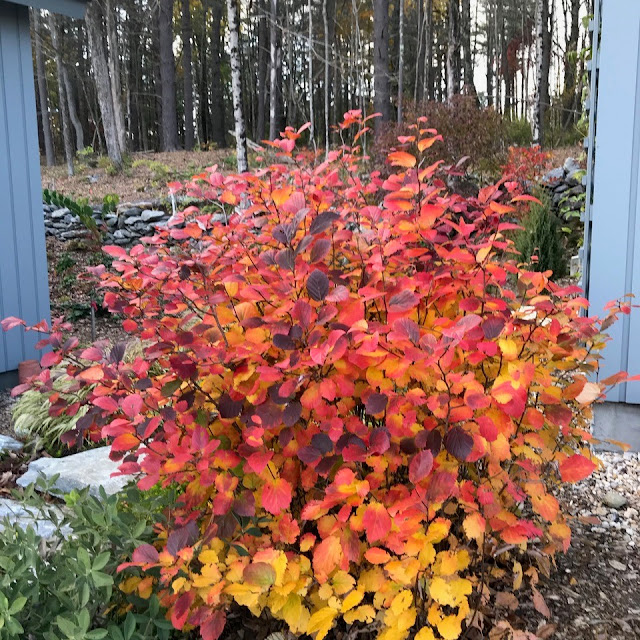There can be a tendency for landscape designers to have a set number of plant taxa in their design portfolio. The plants in the portfolio are reliable and perform, and they can be found at the local nursery or pickup yard, so they stick with the tried and true. The downside is that there is a good chance one's designs look a lot like everyone else's.
Adding new and improved plants to your designs can set your designs apart and help you command higher margin jobs and clients. Plants that perform better and have multiple seasons of interest add greater value to a landscape or garden. Really good plants that exceed expectations can make you into a landscape design genius, particularly compared to the competition that does not keep up with the best plant materials. Here I have listed six outstanding plants that will make you stand out from the crowd.
'Aphrodite' Calycanthus 'Aphrodite' PP#24,014
Think of it as a red-flowered, dwarf magnolia that flowers from June until frost. It is a large shrub or small tree (6'-12'), so place it where it has room to shine. It is an excellent plant for making an informal flower hedge or for blocking unsightly views. 'Aphrodite' is a hybrid between our native sweet shrub and its Asian cousin.
Double Take Eternal White® Chaenomeles speciosa 'SMNCSDW' PP#35,018
A new, continuously flowering, thornless quince with big, double white flowers that provide visual impact even when the plant is in full leaf. This is the longest-blooming flowering quince on the market. Its large, doubled blooms appear in spring, and the show continues for months, often into early autumn. The delicious, camellia-like flowers open lime and then transition to pure white, and the dark green foliage adds the perfect contrast. This quince is a lower, wider-growing shrub than the other Double Take varieties, making it useful in many landscape areas.
'Sweet Summer Love' Clematis 'Sweet Summer Love' PP#24,044
Your clients will rave about your genius because 'Sweet Summer Love' clematis produces thousands of fragrant, red-violet blooms from mid-summer until fall, and its rich, cherry-vanilla fragrance is so delightfully intoxicating. So drape it over a trellis, fence, or post near an entrance door or a well-traveled path. Unlike Sweet Autumn clematis, this plant is seedless, aka non-invasive, so you'll never get unwanted seedlings. It is super healthy and does not get wilt disease or easily die off like many big-flowered clematis. The care is simple; just cut it back, like a perennial, to 1-2' each fall or early spring. That's it. Every summer your clients will remember you and your genius design!
Let's Dance Sky View® Hydrangea macrophylla × serrata 'SMNHSME' PP#34,327
Let's Dance Sky View hydrangea hybrid (H. macrophylla × serrata) is a standout for consistent, yearly blooming, whether you grow it in Michigan or Florida. Selected from our extensive Let's Dance hydrangea breeding program for its ability to not only conserve its old wood buds in the face of weather challenges but also its ability to continue creating new flowers. You'll also love how easy this cultivar is to turn blue, which is what I recommend since it’s so spectacular this way: flowers emerge a beautiful soft blue with a honeydew-green eye before maturing to a full sky blue. Its nice compact growing habit makes it both the front of the border, mass plantings, or as a container plant.
Limelight Prime® Hydrangea paniculata 'SMNHPPH' PP#32,511
An improved, more refined Limelight with darker, healthier-looking foliage, stronger stems, and a more compact growth habit. The blooms emerge a vivid lime green and maintain that color longer, often until they transition into a bubblegum pink. The blooms eventually finish a rich, punch pink. You no longer get the sagging branches and chlorotic foliage you get with 'Limelight'.
Double Play Doozie® Spiraea x NCSX2' PP#30,953;
The first of its kind. A non-stop bloomer because it's sterile! The absence of seed makes it a noninvasive, perpetual bloomer that puts all of its energy into creating wave after wave of red-pink flowers from early summer through frost. No deadheading required! Foliage emerges in shades of red and lime green before maturing to a dark green. Double Play Doozie® spirea is incredibly low-maintenance and naturally grows as a neat mound but responds well to pruning if any shaping is desired.
Bloomerang Ballet Syringa 'SMNSPH' PP#35,934
Bloomerang Ballet® is the best pink reblooming lilac to date. Every year it puts on a remarkable show in both our Europe and N. America trial gardens. Who would have thought we could have fragrant lilacs that bloom like this beyond spring? It flowers in May, then takes a rest, and then blooms again from July until frost. Year after year, Bloomerangs provide nectar and pollen nearly all season long.



















































